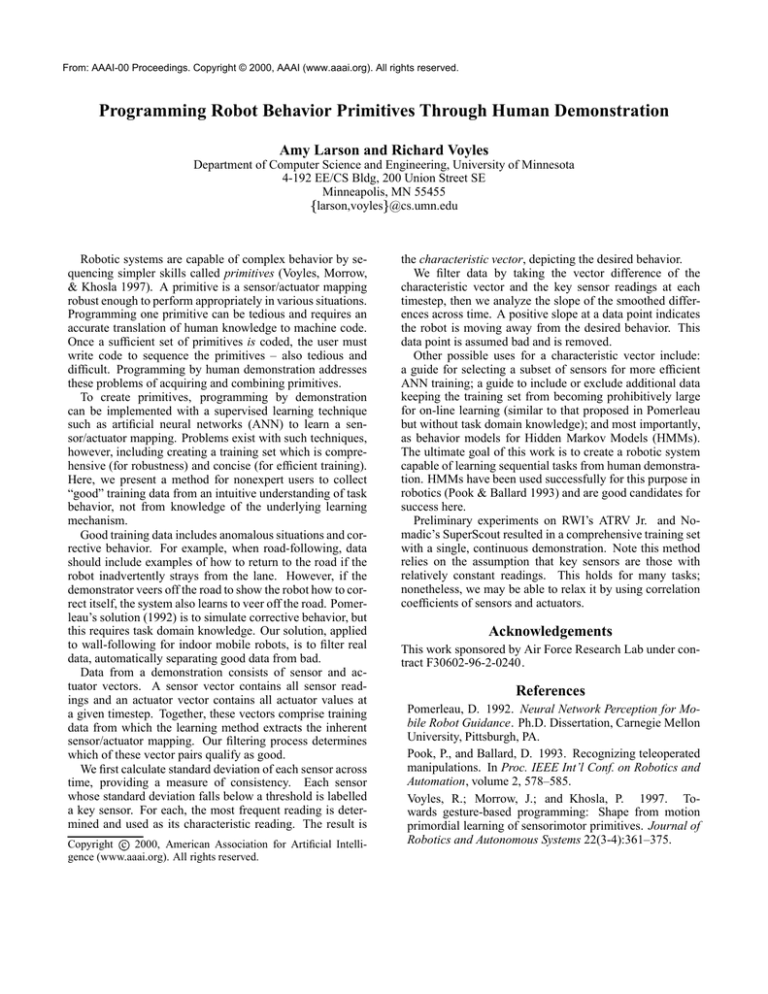
From: AAAI-00 Proceedings. Copyright © 2000, AAAI (www.aaai.org). All rights reserved.
Programming Robot Behavior Primitives Through Human Demonstration
Amy Larson and Richard Voyles
Department of Computer Science and Engineering, University of Minnesota
4-192 EE/CS Bldg, 200 Union Street SE
Minneapolis, MN 55455
larson,voyles @cs.umn.edu
Robotic systems are capable of complex behavior by sequencing simpler skills called primitives (Voyles, Morrow,
& Khosla 1997). A primitive is a sensor/actuator mapping
robust enough to perform appropriately in various situations.
Programming one primitive can be tedious and requires an
accurate translation of human knowledge to machine code.
Once a sufficient set of primitives is coded, the user must
write code to sequence the primitives – also tedious and
difficult. Programming by human demonstration addresses
these problems of acquiring and combining primitives.
To create primitives, programming by demonstration
can be implemented with a supervised learning technique
such as artificial neural networks (ANN) to learn a sensor/actuator mapping. Problems exist with such techniques,
however, including creating a training set which is comprehensive (for robustness) and concise (for efficient training).
Here, we present a method for nonexpert users to collect
“good” training data from an intuitive understanding of task
behavior, not from knowledge of the underlying learning
mechanism.
Good training data includes anomalous situations and corrective behavior. For example, when road-following, data
should include examples of how to return to the road if the
robot inadvertently strays from the lane. However, if the
demonstrator veers off the road to show the robot how to correct itself, the system also learns to veer off the road. Pomerleau’s solution (1992) is to simulate corrective behavior, but
this requires task domain knowledge. Our solution, applied
to wall-following for indoor mobile robots, is to filter real
data, automatically separating good data from bad.
Data from a demonstration consists of sensor and actuator vectors. A sensor vector contains all sensor readings and an actuator vector contains all actuator values at
a given timestep. Together, these vectors comprise training
data from which the learning method extracts the inherent
sensor/actuator mapping. Our filtering process determines
which of these vector pairs qualify as good.
We first calculate standard deviation of each sensor across
time, providing a measure of consistency. Each sensor
whose standard deviation falls below a threshold is labelled
a key sensor. For each, the most frequent reading is determined and used as its characteristic reading. The result is
Copyright c 2000, American Association for Artificial Intelligence (www.aaai.org). All rights reserved.
the characteristic vector, depicting the desired behavior.
We filter data by taking the vector difference of the
characteristic vector and the key sensor readings at each
timestep, then we analyze the slope of the smoothed differences across time. A positive slope at a data point indicates
the robot is moving away from the desired behavior. This
data point is assumed bad and is removed.
Other possible uses for a characteristic vector include:
a guide for selecting a subset of sensors for more efficient
ANN training; a guide to include or exclude additional data
keeping the training set from becoming prohibitively large
for on-line learning (similar to that proposed in Pomerleau
but without task domain knowledge); and most importantly,
as behavior models for Hidden Markov Models (HMMs).
The ultimate goal of this work is to create a robotic system
capable of learning sequential tasks from human demonstration. HMMs have been used successfully for this purpose in
robotics (Pook & Ballard 1993) and are good candidates for
success here.
Preliminary experiments on RWI’s ATRV Jr. and Nomadic’s SuperScout resulted in a comprehensive training set
with a single, continuous demonstration. Note this method
relies on the assumption that key sensors are those with
relatively constant readings. This holds for many tasks;
nonetheless, we may be able to relax it by using correlation
coefficients of sensors and actuators.
Acknowledgements
This work sponsored by Air Force Research Lab under contract F30602-96-2-0240.
References
Pomerleau, D. 1992. Neural Network Perception for Mobile Robot Guidance. Ph.D. Dissertation, Carnegie Mellon
University, Pittsburgh, PA.
Pook, P., and Ballard, D. 1993. Recognizing teleoperated
manipulations. In Proc. IEEE Int’l Conf. on Robotics and
Automation, volume 2, 578–585.
Voyles, R.; Morrow, J.; and Khosla, P. 1997. Towards gesture-based programming: Shape from motion
primordial learning of sensorimotor primitives. Journal of
Robotics and Autonomous Systems 22(3-4):361–375.





